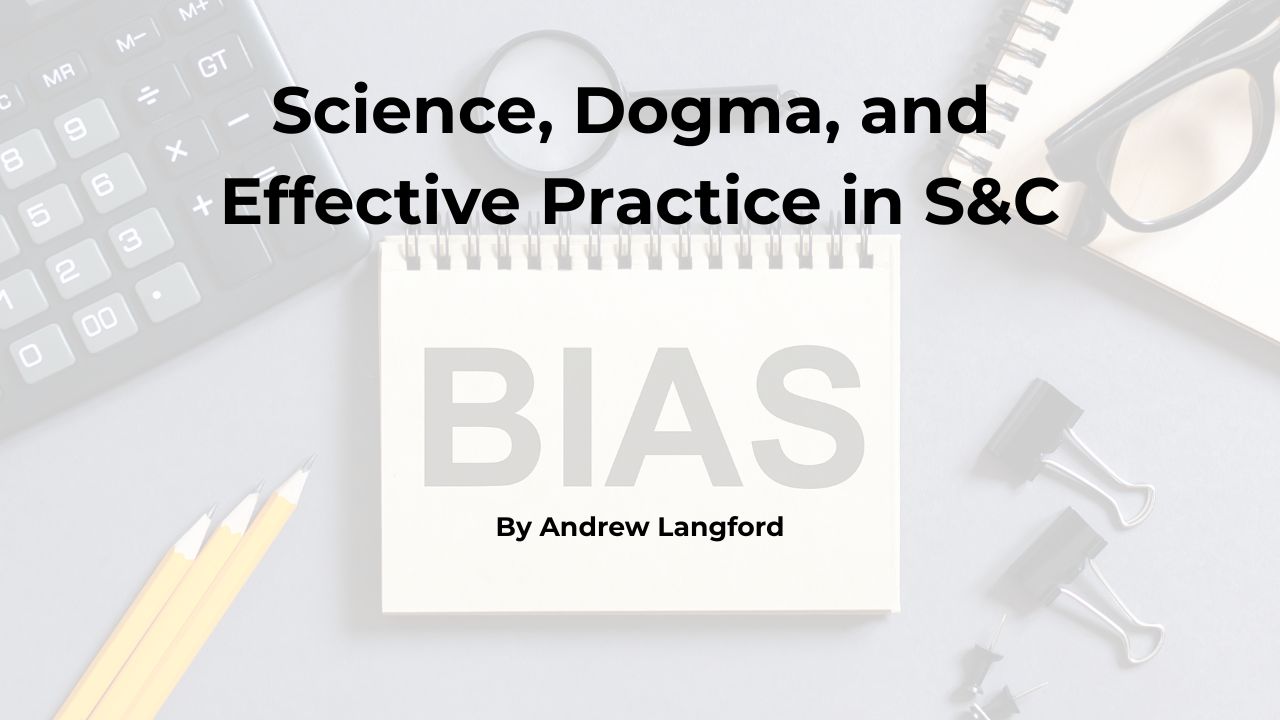[mashshare]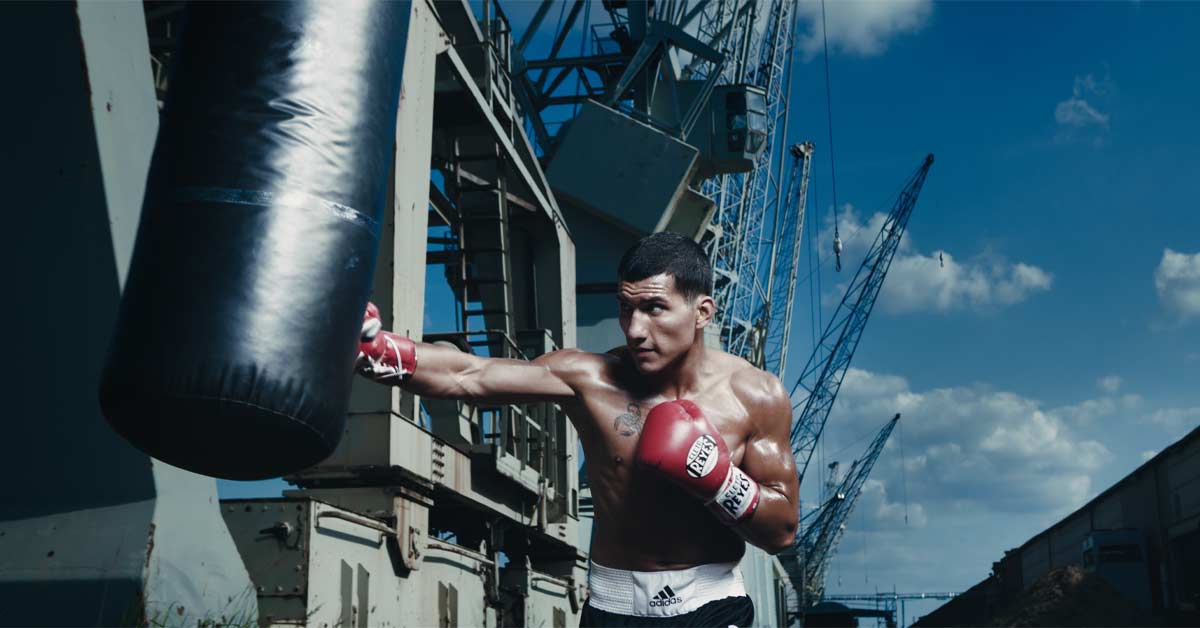
Whether it’s MMA, boxing, or the nonsense we see action stars perform in movies, one factor that fascinates us about fighting is punching power. Some people believe that striking power is a gift, which to some extent is true, as evidenced by the number of fighting champions who never touched a barbell. Yes, talent often does prevail, but the fact is that anyone, at any level, can become a more powerful puncher.
Anyone, at any level, can become a more powerful puncher. Share on XHaving trained five professional world champions and three Olympic champions in boxing, I have to start this discussion by saying that it takes more than powerful punches to excel in boxing. When Connor McGregor faced off against Floyd Mayweather, Jr., two years ago, many sports writers were giving McGregor a “puncher’s chance,” meaning that a few solid blows by the MMA superstar could take down the undefeated champion.
The boxing community knew better.
The May-Mac spectacle was undoubtedly entertaining, but the one thing it proved is that boxing is more than just striking. Being able to take punches or, better yet, avoid taking punches (a skill that Mayweather has mastered like no other), is also part of the sport. That said, what do the big hitters in boxing—legends such as Tyson, Foreman, and Durán—have in common?
First, they know how to punch. A powerful boxer puts their entire body behind their punches. Just as a quarterback’s throwing power doesn’t come from flexing their triceps, a boxer learns how to transfer power from their legs and torso to their shoulders, arms, and hands. Watch his fight films and you’ll see that Tyson’s most potent punches often began from a semi-squat and followed through with trunk rotation and total body extension.
Common Mistakes in Training Fighters
Along with technique, boxers need to be strong. But just as importantly, they need to be able to apply that strength quickly. Before getting into what strength training methods work to increase punching power, let’s talk about three popular methods that don’t work.
Shadowboxing with Dumbbells
The first is shadowboxing with 1- to 2-kilo (2- to 5-pound) dumbbells. Yes, I realize that Mayweather has been seen performing this training method, but I would argue that Mayweather is 50-0 in spite of this training, not because of it. Why? Shadowboxing with weights adversely affects the fine-movement patterns of punching and places a high level of stress on the shoulders.
Citing the example of Newton’s Second Law of Motion, sports scientist Dr. Mel Siff said, “…the force generated with light dumbbells can actually be larger than with heavy weights moved slowly. The momentum attained with light weights often forces the joints passively beyond their normal range of muscularly controlled movement and constitutes a form of excessively strenuous ballistic stretching.” I agree, and would add that one of my former boxers told me that he severely injured his shoulders soon after he started shadowboxing with dumbbells.
Hitting Tires with Sledgehammers
The second type of training I dislike that is popular among fighters is hitting tires with sledgehammers. Yes, such pounding gives the oblique abdominals a heck of a workout and can be effectively used for energy-system training, but it’s extremely harsh on the shoulders. With my fighters, I would rather avoid this exercise altogether, or at least use it infrequently.
Too Much Aerobic Exercise
Lastly, those who want to pack a powerful punch need to be careful about performing an excessive amount of aerobic exercise. Aerobic training can compromise fast-twitch muscle fibers, making them behave like slow-twitch fibers, and cause overtraining.
Now that you know what I don’t like, let’s look at the equipment and several training methods that I guarantee will increase punching power.
Punching Power: The Equipment
One of the most obvious ways to develop punching power (and one that fulfills the requirements of sports specificity) would be to hit a heavy bag. I agree, but a fighter has to be careful about overdoing it. Next to the hand and wrist, the second most commonly injured body part with boxers is the shoulder. One extensive review on the subject attributed this issue to “the repetitive and forceful delivery of punches.” That said, let’s look at the types of heavy bags available.
Heavy Bags
One heavy bag that I will never have any of my fighters use is the standing bag. These are often popular in martial arts studios and commercial fitness gyms because they are easy to move, don’t require special installation, and don’t take up much space. The problem is that they are stiff and, as such, transfer too much stress to the shoulder—you’d be better off visiting a butcher and hitting slabs of meat like Rocky!
One heavy bag that I don’t have my fighters use is the standing bag. Because they are stiff, they transfer too much stress to the shoulder. Share on XNext is the heavy bag attached from the ceiling with a rope or chain. These are less stressful on the upper extremities, but I only focus on using them during the early stages of training (i.e., far away from a fight) and my athletes don’t hit them every day.
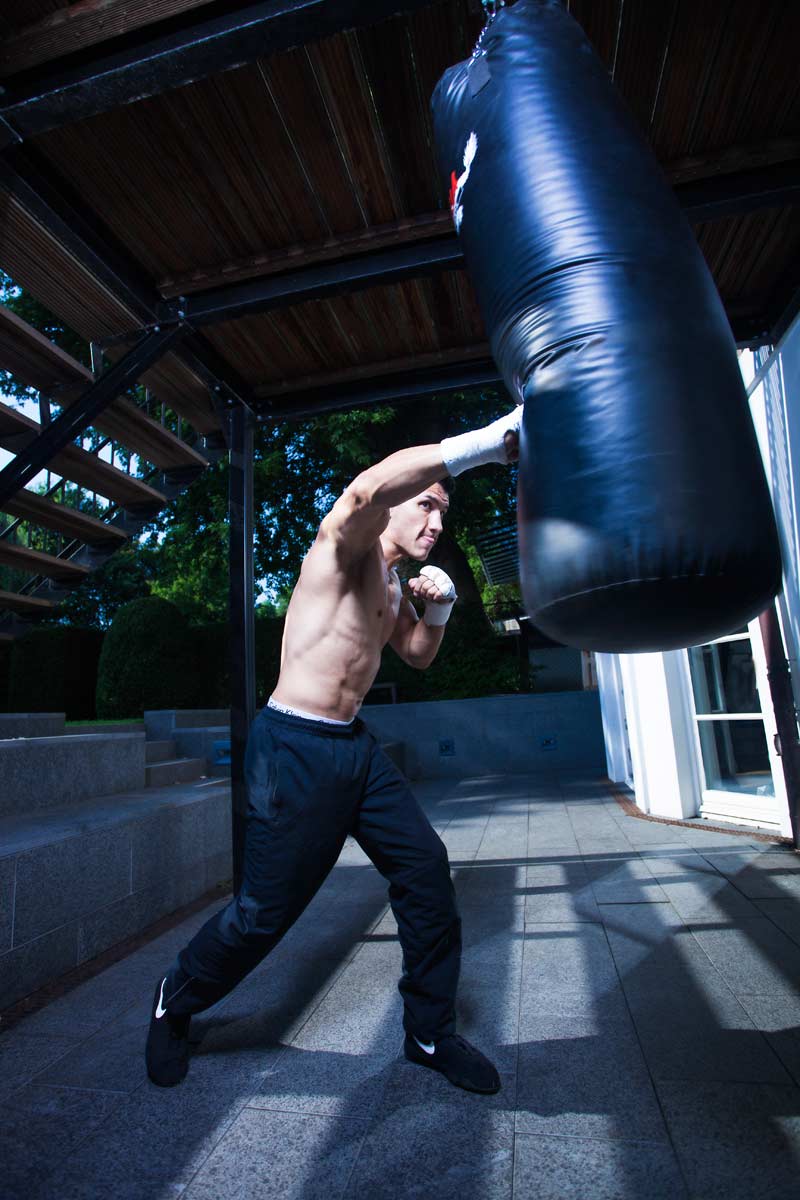
As a fight approaches, I have them switch to double-end bags, which have less impact on the shoulders. Double-end bags are attached to both the ceiling and the floor with tight coils. The coils enable the bag to snap back quickly when punched, thus simulating the response of an opponent. That is, it enables the fighter to practice the counterstriking and defensive movement skills they would need in a fight.
Gloves
Regardless of which heavy bag you choose, it’s important to invest in the appropriate gloves. The open-fingered gloves used by MMA fighters will not protect your hands, nor will the lighter speed bag gloves. You should also learn from a professional how to tape your hands, and always replace worn-out gloves well before they need replacing.
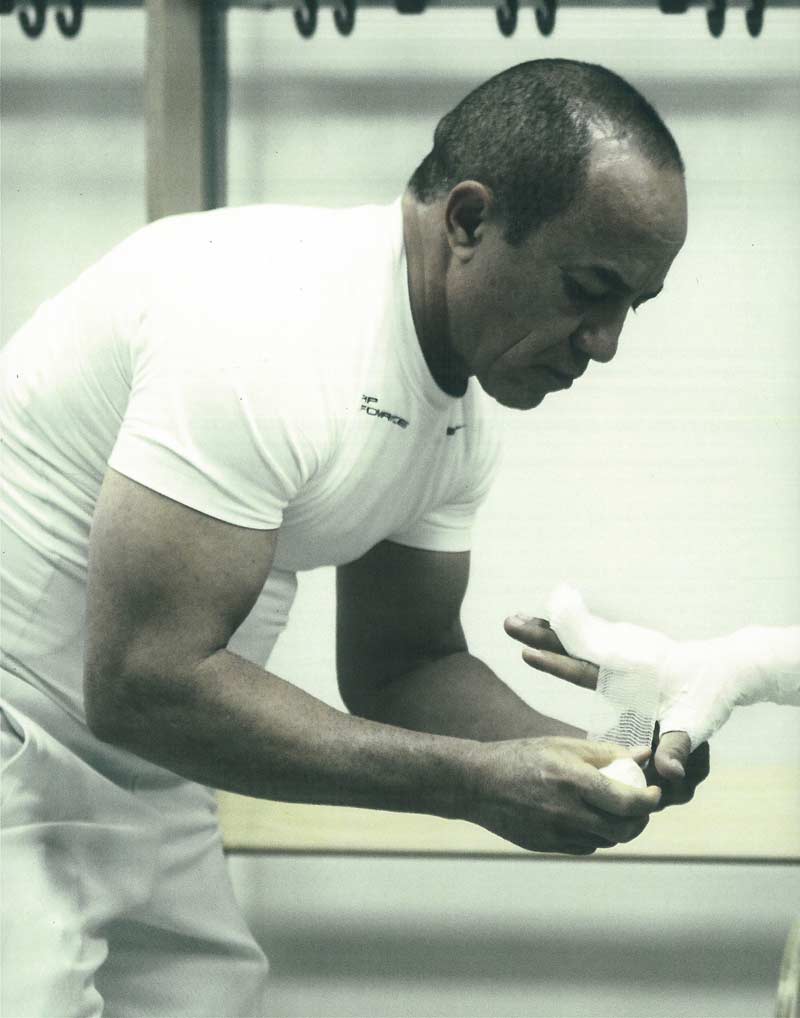
Some gloves have more padding around the wrist to increase the strength of the punch. Examples of these are the Cleto Reyes® and Grant® gloves, which are often referred to as a “puncher’s glove.” My fighter Yuriorkis Gamboa, a unified world flyweight champion, wore this type of glove.
Another type of glove that is especially popular for training is the type that has more padding on the front of the hands to protect them. The Winning® glove from Japan has this design, and they are often referred to as “pillows.” Mayweather dealt with numerous hand injuries in his career and he prefers these types of gloves for training. However, for a fight he would switch to a puncher’s glove such as Grant, as they would cause more damage.
Now let’s talk about strength training!
Punching Power: What Exercises Work
Most of my strength training is performed with free weights, and as a result, my fighters are strong. Very strong! Gamboa, who finished 17 of his 31 fights by knockout, could perform chin-ups for reps with 41 kilos (90 pounds) attached to his waist, incline bench press 100 pounds over his body weight, and carry cylinders that weighed double his body weight for 40 meters (131 feet). I’ll put those numbers up against any fighter, even those several weight classes above him.
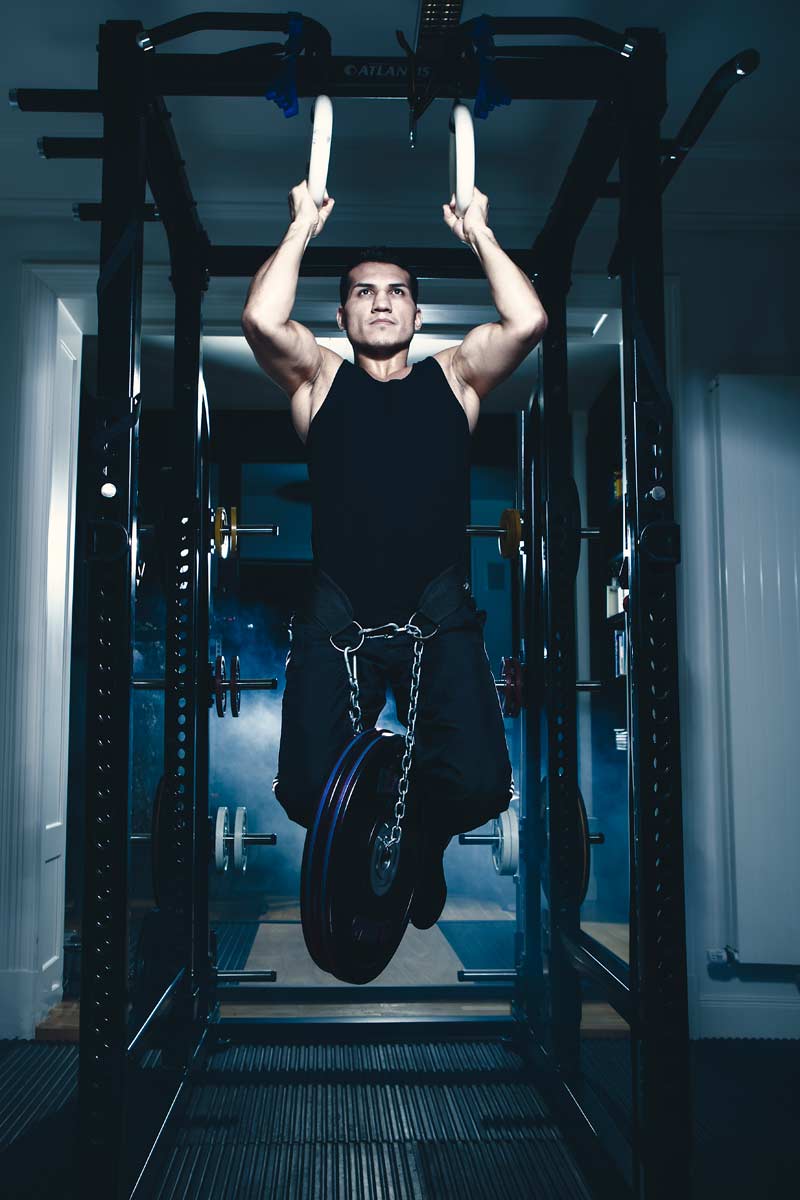
Before getting into the exercises, let’s look at sets and reps. As a general rule, I believe in using relatively low repetitions with heavy weights to achieve maximum strength with minimal increase in muscle mass (i.e., relative strength). Unless a fighter is in the heavyweight class and wants to put on mass for mass sake, they shouldn’t train like a bodybuilder using relatively light weights and high reps.
As with most strength coaches, I am a fan of squats, but you have to be careful because this exercise can easily add a large amount of muscle mass and force a fighter into a higher bodyweight class. For fighters, I prefer lunges, split squats, and hex bar deadlifts. The Olympic lifts are great, but fighters shouldn’t do them without getting proper instruction.
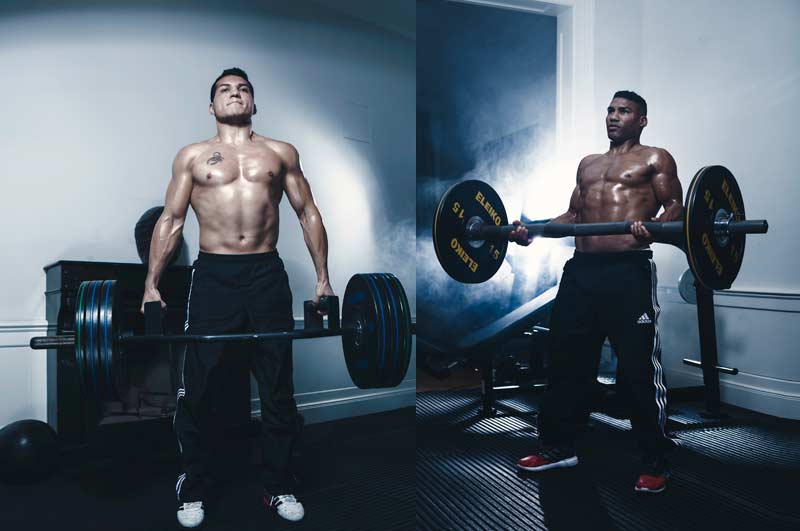
For the upper body, my two go-to exercises are incline presses and chin-ups. For these exercises, and many other upper body movements, I prefer thick-grip equipment such as barbells and dumbbells. Hard punches need to be backed up with strong wrists and hands, and thick-grip training is one of the most practical ways to strengthen these areas.
Hard punches need to be backed up with strong wrists and hands, and thick-grip training is one of the most practical ways to strengthen these areas. Share on XWith incline presses, I often use contrast training, which applies the neurological phenomenon known as post-tetanic facilitation (PTF). The basis of PTF is that a more powerful muscular contraction can be produced if that contraction is preceded by a strong muscular contraction. To use an example, a fighter could work up to 3×3 of heavy incline presses supersetted with 3×10 medicine ball chest passes, or chin-ups for 3×3 (using added resistance) supersetted with 3×10 medicine ball overhead throws.
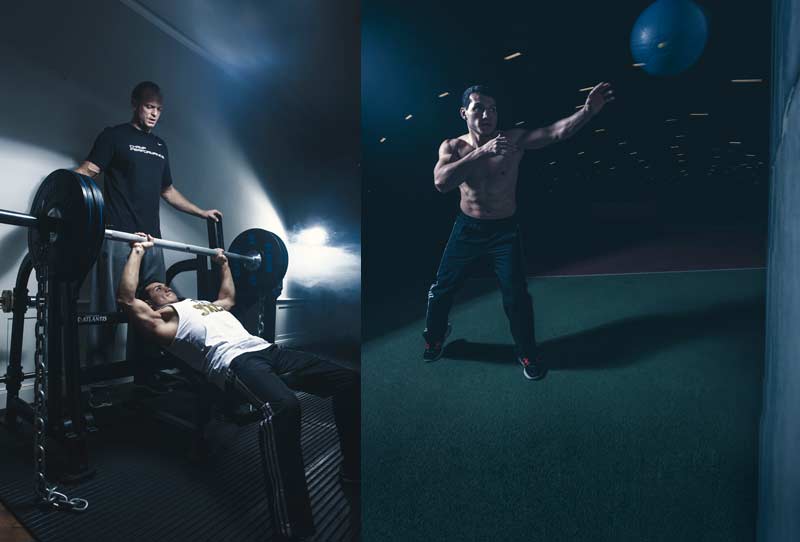
To give you an idea of how I make fighters more powerful, the following is a two-week resistance-training workout I’ve used with one of my world champions. This workout was performed in their early preparation phase (so, far away from a fight).
Upper Body (Monday and Thursday)
A1. Incline bench press, dumbbells, twist semi to pro 3, 4 x 5-7, 31×0, rest 100 seconds
A2. Wide-grip pull-up, 4 x 5-7, 30×1, rest 100 seconds
B1. External rotation infraspinatus, low pulley, 4 x 8-10, 20×0, rest 100 seconds
B2. One-arm dumbbell rowing, elbowing, 4 x 5-7, 30×0, rest 100 seconds
C1. Neck work, Swiss ball, 4 x 4-6, 8 seconds, rest 90 seconds
C2. Seated dumbbell curl, offset grip, 4 x 5-7, 30×0, rest 90 seconds
C3. Decline triceps extension, EZ bar with chains, 4 x 5-7, 30×0, rest 90 seconds
D1. Pinch grip, 3 x 2, 30 seconds, rest 60 seconds
D2. Wrist rotation, 3 x 10, 2120, rest 60 seconds
Lower Body (Tuesday and Friday)
A1. Drop Lunge, Dumbbell, 4 x 5-7, 40X0, rest 100 seconds
A2. Lying Leg Curl, 4 x 5-7, 30X0, rest 100 seconds
B1. Side Step-Up, 4 x 5-7, 10X0, rest 100 seconds
B2. Glute-Ham Raise, 4 x 5-7, 30X0, rest 100 seconds
C1. Power Crunches, Barbell, 3 x 5-7, 30X0, rest 90 seconds
C2. Isometric Crunch, 3 x 5-7, 30X0, rest 90 seconds
Weight Loss and Punching Power
Finally, I need to touch on the subject of weight loss and punching power. If a fighter loses body fat improperly or steps into the ring dehydrated, it will sap their strength and thus reduce their punching power. One estimate is that a dehydration level of 3% reduces muscular power by 19%!
Is this a problem in fighting sports?
Weight loss preparation before a fight is a serious matter and only somebody who know what they’re doing should administer it. Share on XIn one study, researchers found that 39% of the MMA fighters observed entered their fights with significant levels of dehydration. Further, several years ago the death of a Muay Thai fighter, a teenage girl, was caused by dehydration; and in 1997, three collegiate wrestlers died from weight loss complications. These are just a few tragic examples of poor weight loss management. My point is that weight loss preparation before a fight is a serious matter and should only be administered by those who know what they are doing.
I hope the ideas presented in this article gave you a good introduction to what it takes to develop devastating punches. Don’t stop here—become a student of the fighting sports and see just how powerful you or your athletes can become!
Note: Header photo also by Christian Barz
Since you’re here…
…we have a small favor to ask. More people are reading SimpliFaster than ever, and each week we bring you compelling content from coaches, sport scientists, and physiotherapists who are devoted to building better athletes. Please take a moment to share the articles on social media, engage the authors with questions and comments below, and link to articles when appropriate if you have a blog or participate on forums of related topics. — SF
[mashshare]
References
Siff, M. Facts and Fallacies of Fitness, 4th Edition, 2000, p. 114.
Caine, D., Caine, C. Koenraad, L. Epidemiology of Sports Injuries. Human Kinetics Publishers, Inc., 1996. p. 117.
Jetton AM1, Lawrence MM, Meucci M, Haines TL, Collier SR, Morris DM, Utter AC. “Dehydration and acute weight gain in mixed martial arts fighters before competition.” J Strength Cond Res. 2013 May;27(5): pp.1322-6.



